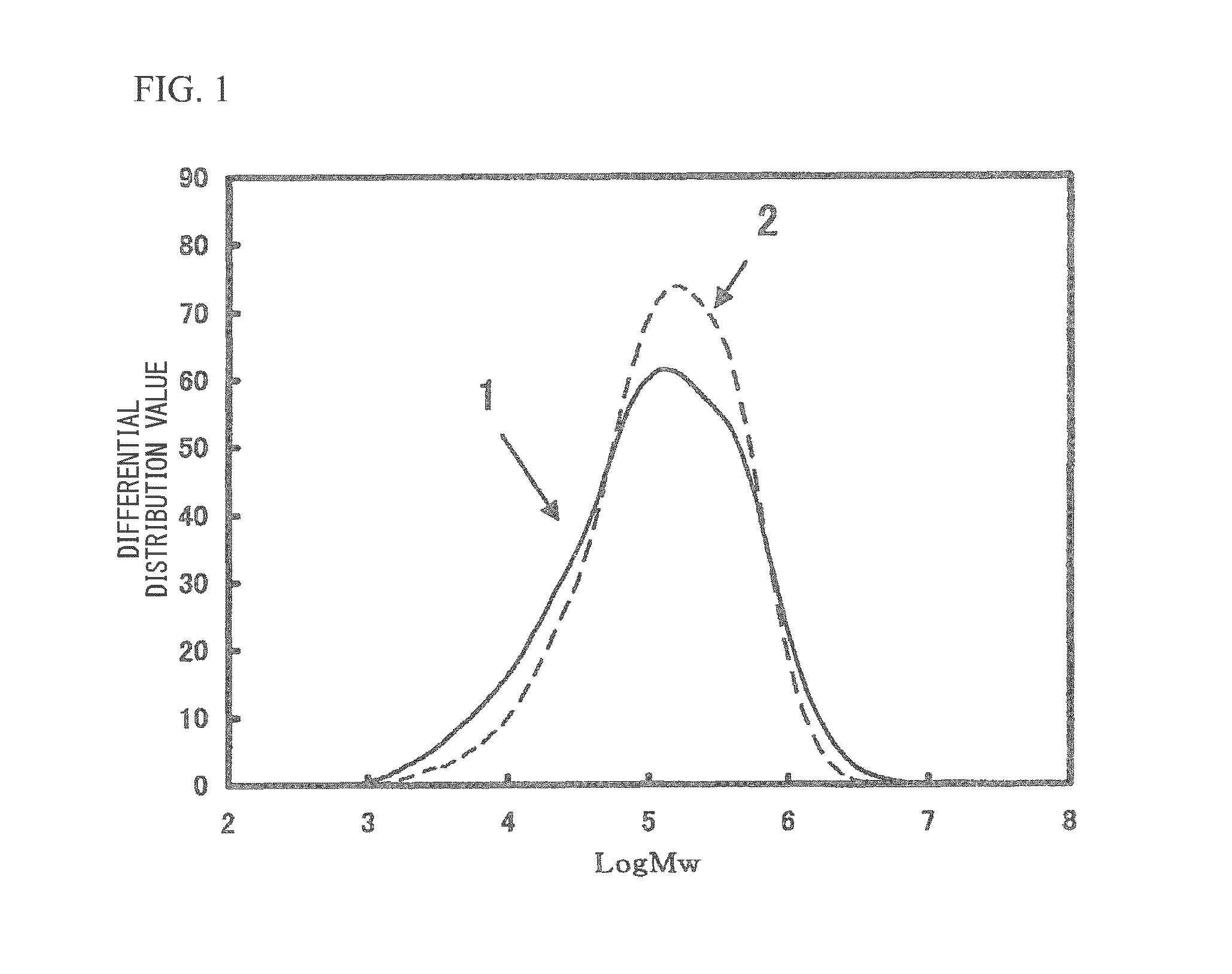Biaxially stretched polypropylene film for capacitors
a polypropylene film and capacitor technology, applied in the direction of fixed capacitor details, instruments, transportation and packaging, etc., can solve the problems of inability to meet the demands of the rapidly developing capacitor market, inability to achieve a level able to adequately satisfy the withstand voltage performance, and easy film breakage, etc., to achieve superior tolerance, wide molecular weight distribution, and high breakdown strength
- Summary
- Abstract
- Description
- Claims
- Application Information
AI Technical Summary
Benefits of technology
Problems solved by technology
Method used
Image
Examples
example 1
[0296]The Polypropylene Raw Material Resin A using the aforementioned solid titanium catalyst component (I) was supplied to an extruder, melted at a resin temperature of 250° C., extruded using a T-die, and wound onto a metal drum and solidified to produce a cast sheet having a thickness of about 250 μm. Continuing, after stretching this unstretched cast sheet by a factor of 5 in the machine direction at a temperature of 150° C. with a compact laboratory stretching device in the form of the KARO IV Laboratory Stretcher manufactured by Brückner GmbH, the sheet was immediately stretched in the transverse direction by a factor of 10 to obtain a thin biaxially stretched polypropylene film having a thickness of 5 μm. The molecular properties of the resulting film and film characteristic values are summarized in Table 1. Furthermore, the difference in molecular weight differential distribution values, molecular weight (Mw), molecular weight distribution (Mw / Mn, Mz / Mn) and mesopentad fract...
example 2
[0297]A thin biaxially stretched polypropylene film having a thickness of 5 μm was obtained in the same manner as Example 1 with the exception of supplying the Polypropylene Raw Material Resin B having a different low molecular weight component content to the extruder instead of the Polypropylene Raw Material Resin A of Example 1. The molecular properties of the resulting film and film characteristic values are summarized in Table 1. Furthermore, the difference in molecular weight differential distribution values, molecular weight (Mw), molecular weight distribution (Mw / Mn, Mz / Mn) and mesopentad fraction shown in Table 1 are analytical values of the polypropylene resin that forms the film.
example 3
[0301]Polypropylene Raw Material Resin A of Example 1 was supplied to an extruder, melted at a resin temperature of 250° C., extruded using a T-die, and wound onto a metal drum held at a surface temperature of 95° C. and solidified to produce a cast sheet having a thickness of about 125 μm. Continuing, after stretching this unstretched cast sheet by a factor of 5 in the machine direction at a temperature of 140° C. and immediately cooling to room temperature, the sheet was stretched in the transverse direction by a factor of 10 with a tender at 165° C. to obtain an extremely thin biaxially stretched polypropylene film having a thickness of 2.5 μm. The molecular properties of the resulting film and film characteristic values are summarized in Table 2. In addition, the withstand voltage properties of a capacitor element produced from the resulting biaxially stretched polypropylene film are summarized in Table 3. Furthermore, the difference in molecular weight differential distribution...
PUM
| Property | Measurement | Unit |
|---|---|---|
| height | aaaaa | aaaaa |
| Ra | aaaaa | aaaaa |
| thickness | aaaaa | aaaaa |
Abstract
Description
Claims
Application Information
 Login to View More
Login to View More - R&D
- Intellectual Property
- Life Sciences
- Materials
- Tech Scout
- Unparalleled Data Quality
- Higher Quality Content
- 60% Fewer Hallucinations
Browse by: Latest US Patents, China's latest patents, Technical Efficacy Thesaurus, Application Domain, Technology Topic, Popular Technical Reports.
© 2025 PatSnap. All rights reserved.Legal|Privacy policy|Modern Slavery Act Transparency Statement|Sitemap|About US| Contact US: help@patsnap.com

